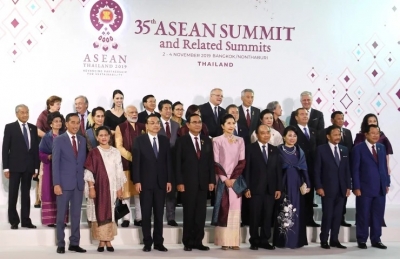By Baladas GhoshalNew Delhi, Jan 7: Southeast Asia, as it was in the 1960s and ’70s, has again become the fulcrum in the current international relations and global conflict between the two superpowers -this time, however, not between the US and the Soviets but US and China, the latter being the rising delinquent, new muscleman in the town with deep pockets.
Strategic location between the Pacific and the Indian Oceans, together with the region’s proximity to Beijing lends it an added significance in the emerging battleground, if not in military confrontation, but surely in rivalry for influence through other means.
ASEAN centrality has to be rephrased as Southeast Asian centrality, as the region has become the fulcrum not the organization, which is not only divided on the question of China but also has failed to provide any leadership on any major crisis affecting the region, the latest example being the Myanmar crisis.
Individual countries of the region, rather than ASEAN as an organisation have become the focus of outreach for others.
This is not to undermine the organisation as such, but only to suggest that ASEAN can act effectively if it is united and speaks with one voice.More importantly, ASEAN centrality could work till the time American and Chinese interests over the region’s security and economic architecture converged.
Deteriorating Strategic Environment and China-American rivalry
Certain developments in recent years have contributed to the deteriorating strategic scenario in the entire Indo-Pacific and America’s concern and renewed interest in the region.Beijing’s bellicosity towards all, except towards its client states, added by its wolf-warrior diplomacy and creeping occupation of most of its neighbours’ territories, as well as its increasing assertiveness in the South China sea finding expression in the salami-slicing strategy and building of artificial islands and their militarization, are the most important factors for building up tensions in the region.This in turn, has resulted in the US worry that it might be losing the ground to the Chinese hegemony and a Beijing-centric economic and strategic order in the Indo-Pacific region.
Washington’s concern with Beijing’s hegemonic ambition actually began even during the period of Trump administration, but it was inchoate, desultory and sometimes incoherent.It is only during the Biden administration, that too not in the early months of its office, that it received much more coordinated focus and an attempt to chart out a strategy to deal with the China challenge.
It was also triggered by the concern in the minds of its allies and partners in the region that the US is on a decline and a doubt about its commitment to retain itself as the resident power and as a security provider guaranteeing the safety and security of the countries that come under China’s assault or influence.
It has not escaped the attention of Southeast Asians that Cabinet-level officials from the Biden team had made early visits to Japan, India, and South Korea, but not to the region.In contrast, Chinese diplomacy has gone into hyper drive over the past year, including its vaccine diplomacy, with top Chinese diplomats meeting Southeast Asian counterparts by some counts, at least 21 times, if not more, since August 2020.
As a result, Southeast Asian countries, much against their wishes, have more- or- less reconciled to Beijing’s hegemony in the region, but tried hard to minimise its effects and damage to their territorial sovereignty and integrity as well as to avoid coming under its economic stranglehold through a strategy of hedging and building defence and economic cooperation with the US, EU, Japan, India and Australia without giving an impression of joining an anti-China alliance.It was a difficult strategy with the possibility of very little success.
Nevertheless, it was their preferred choice, as they were not sure whether anyone would come to their rescue if they opted to confront China, a much bigger and powerful neighbour.US power was overstretched and preoccupied with other areas.
The others with their combined strength would not be able to match China’s military and economic power.
US outreach to Southeast Asia
But things began to change in recent months, with the US shedding off its earlier inertia and waking up to the importance of Southeast Asia in facing the China challenge in the Indo-Pacific region with high-level visits by Deputy Secretary of State Wendy Sherman in May 2021, Defence Secretary Lloyd Austin in the following month to shore up defence cooperation, followed in so in many ways by Vice President Kamala Harris’s visit to build on the momentum of these recent efforts.
It was also a broader effort to re-engage with key partners in Southeast Asia, as US engagement had waned during the Trump administration and also got off to a slow start under Biden, as mentioned earlier.
For US foreign policy and American interests, the stakes are very big in the region, as almost 42,000 US companies export to the 10 countries that make up the Association of Southeast Asian Nations, or ASEAN, supporting about 600,000 jobs in the US And Southeast Asia also includes two US allies, Thailand and the Philippines, as well as important security partners like Singapore and key emerging partners like Vietnam and Indonesia, a country that at one time was the main pillar of its major outreach to the region.
President Joe Biden participated in a US-ASEAN virtual summit in October, pledging to deepen cooperation with the bloc.The US has previously voiced support for some ASEAN countries in tensions with China over the South China Sea, a major trade route that Beijing claims as its own.
Secretary of State Anthony Blinken’s maiden visit to Indonesia and Malaysia last month added to its earlier efforts to step up Washington’s engagement with individual countries of Southeast Asia to shore up its Indo-pacific strategy.All of them focussed on America’s vision for the Indo-Pacific region under the Biden administration putting forward a positive vision of peace and stability, freedom of the seas, unimpeded commerce, advancing human rights – including in places like Burma – and a commitment to the international rules-based order.
Blinken lauded “Indonesia’s leadership” in the Indo-Pacific calling the country “the world’s third-largest democracy and a strong proponent of the rules-based international order,” the statement read.After Blinken’s meeting with Indonesian president Jokowi, the country’s Foreign Minister Retno Marsudi said Washington appeared interested in forging partnerships with Jakarta, including on infrastructure.”The US commitment was very noticeable,” Retno told reporters.Blinken also congratulated Jokowi on Indonesia’s G20 presidency.In Malaysia, Blinken commended its handling of the Covid-19 pandemic and was also appreciative of its contribution of vaccines to COVAX, a world-wide vaccine sharing initiative.”This is deeply appreciated and evidence of real leadership,” he said during a joint press conference with Malaysian foreign minister Saifuddin Abdullah.All nice and pleasing words were said at the targeted audience.
Unfortunately, due to one the members of the entourage being infected with Covid-19, Blinken could not make the last leg of his tour, i.e., Thailand, which created some misgivings among the Thais about his mission to the region.Thitinan Pongsudhirak, a leading Political Scientist from Chulalongkorn University puts the Thai sentiments very aptly: “Having skipped Thailand US Secretary of State Antony Blinken’s .aborted three-country tour of Southeast Asia has hindered the full projection of President Joe Biden’s Indo-Pacific geostrategy.Not wrapping up the trip with a visit to Thailand, a mainland Southeast Asia pivot and longstanding US treaty ally, also misses an opportunity to shore up what has been a relative bilateral estrangement.In short, Secretary Blinken’s diplomatic foray in Southeast Asia has fallen “short for the time being.” Leaving aside this minor hitch, the optics of all the visits and their interactions were quite impressive.
Can the US carry along the Southeast Asians with its current Indo-Pacific strategy?
Optics were good, but the substance was missing.”Despite its deep regional expertise and the region’s high expectations, it has failed to articulate a comprehensive regional strategy or treat the Indo-Pacific as its decisive priority,” to quote a report by four scholars of the US studies Center.The Biden administration’s focus on long-term systems competition with China overlooks the urgency of near-term competition in the Indo-Pacific.
It sees the United States as being in a “systems competition” between democracy and autocracy.By making ideological competition with China an organising principle for US foreign policy, Washington risks undermining its attractiveness as a partner for politically diverse Indo-Pacific countries.
It also cannot compete against China effectively in the Indo-Pacific without prioritising engagement with Southeast Asia, particularly Indonesia.The outreach had been too late and too little in substance.
It has recognised the need to do more in Southeast Asia, but its success may be limited by its approach to competition with China and lack of an economic strategy, which essentially is a function of US protectionist trade preferences at home.Proposed initiatives on digital trade and infrastructure cannot compensate for the absence of a comprehensive trade-based economic approach.”The Biden administration views China as a predominantly long-term military challenge.Its efforts to minimise spending on US forward posture in the region suggest it may be less committed to a strategy of deterrence by denial to prevent Chinese aggression,” to quote the US studies Center report again.
It is important to recognize that most ASEAN countries, due to their small size and military weakness, are wary of taking sides if either US or China want to have constructive relations with both, and they often feel caught in the middle.And therefore, it’s also important for the US to engage these countries on their own terms, based on a positive political and economic agenda, rather than “approaching them simply as derivative of US competition with Beijing”.
The US recognizes that China is increasingly achieving its strategic goals in Southeast Asia through economic statecraft, illustrated in its Belt and Road Initiative and proactive role in forming RCEP, which is the mega-trade deal that is expected to accelerate the region’s economic integration with China, which is already very significant.The US had a very good prospect of economically integrating Southeast Asia with the Trans Pacific Partnership (TPP), which never entered into force due to the withdrawal of the United States by the Trump administration.
From its failure evolved the Comprehensive and Progressive Agreement for Trans-Pacific Partnership (CPTPP), also known as TPP11 or TPP-11, a trade agreement among Australia, Brunei, Canada, Chile, Japan, Malaysia, Mexico, New Zealand, Peru, Singapore, and Vietnam.
The eleven signatories have combined economies representing 13.4 percent of global gross domestic product, at approximately US$13.5 trillion, making the CPTPP one of the world’s largest free-trade areas by GDP, along with the United States-Mexico-Canada Agreement, the European Single Market, and the Regional Comprehensive Economic Partnership (RCEP).The US must join the CPTPP or must sign a new trade deal involving the Southeast Asian countries, possibly including India.It is through mutually beneficial economic engagement with the Indo-Pacific and adopting trade and investment strategies that the US can reinforce its role as an indispensable resident economic power along with its military capabilities.
India can also emerge as an important actor in this process of economic integration if it can join the group and along with Japan and Australia who have formally launched the Supply Chain Resilience Initiative (SCRI), merge with whichever trading arrangements are initiated in the region in the coming days.The SCRI aims to create a virtuous cycle of enhancing supply chain resilience with a view to eventually attaining strong, sustainable, balanced and inclusive growth in the region.
It is time for New Delhi to seize the opportunity.It is neither India nor the US who can make their Indo-Pacific concept come into fruition without the support of Southeast Asia.
(Baladas Ghoshal, is a former Professor and Chair in Southeast Asian Studies, Jawaharlal Nehru University & Secretary General, Society for Indian Ocean Studies)
(The content is being carried under an arrangement with indianarrative.com)
–indianarrative
#India #Southeast #Asia #economic #nership #balance #Delhi #Joe Biden #Amala #Lal #Jan # Lal #Carry #Washington #China #Delhi #New Delhi #Austin #Washington #Beijing #Jakarta #Singapore #Covid-19
.






